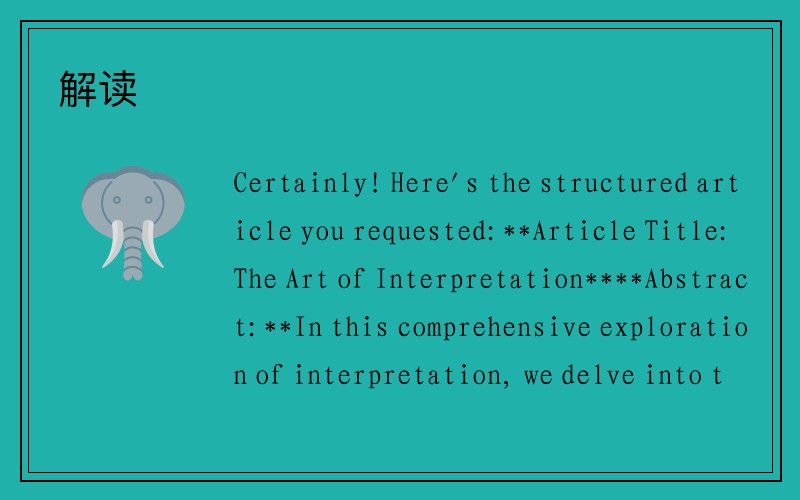Certainly! Here's the structured article you requested:
**Article Title: The Art of Interpretation**
**Abstract:**
In this comprehensive exploration of interpretation, we delve into the multifaceted process of understanding and explicating diverse forms of information. Interpretation, as discussed here, encompasses four key aspects: linguistic interpretation, cultural interpretation, artistic interpretation, and scientific interpretation. Each aspect is examined in detail, highlighting its significance and methodologies. By the end, this article aims to illuminate the essence of interpretation across various disciplines, revealing its profound impact on human understanding and communication.
---
Linguistic interpretation involves more than just translating words; it is about deciphering meaning, nuance, and context from one language to another. At its core, linguistic interpretation bridges communication gaps, ensuring ideas and messages retain fidelity across linguistic boundaries. The complexities of idiomatic expressions, cultural references, and grammatical structures pose challenges that skilled interpreters navigate with precision and cultural sensitivity.
Effective linguistic interpreters must possess not only fluency in multiple languages but also a deep understanding of the cultural contexts in which these languages operate. This cultural awareness is crucial in accurately conveying not just the words but the intended meanings behind them.
Furthermore, technological advancements have revolutionized linguistic interpretation through machine translation and natural language processing. These tools augment human capabilities, offering efficiency while raising questions about the nuances lost in automated translations.
Cultural interpretation delves into the rich tapestry of customs, beliefs, and practices that define societies. It goes beyond mere observation to uncover the underlying values and historical significance embedded within cultural artifacts, rituals, and traditions.

Anthropologists and sociologists employ cultural interpretation to decode the complexities of human behavior and societal structures. By studying cultural norms and behaviors, researchers gain insights into how communities function and evolve over time.
Moreover, in a globalized world, understanding cultural nuances is essential for effective cross-cultural communication and collaboration. Misinterpretations based on cultural differences can lead to misunderstandings and conflicts, highlighting the importance of cultural competence in various fields, from business to diplomacy.
Artistic interpretation explores the realm of creativity and expression across visual arts, literature, music, and performance. Artists and critics engage in interpreting artworks, seeking to unravel the messages, emotions, and symbolism embedded within creative expressions.
Interpretation in the arts is subjective yet informed by cultural, historical, and personal perspectives. Art critics analyze styles, techniques, and themes, offering interpretations that enrich the audience's understanding and appreciation of artistic works.
Furthermore, artistic interpretation extends beyond individual artworks to movements and genres, reflecting broader social and philosophical currents. It serves as a lens through which societal values, ideologies, and aspirations are examined and critiqued.
Scientific interpretation involves the analysis and synthesis of empirical data to generate meaningful conclusions and theories. Scientists interpret experimental results, statistical findings, and theoretical frameworks to advance knowledge in fields ranging from physics to biology.
The rigor of scientific interpretation demands adherence to methodological principles, transparency in data analysis, and peer review. Interpretations are subject to revision based on new evidence, fostering a dynamic process of knowledge refinement and discovery.
Moreover, interdisciplinary collaboration enhances scientific interpretation by integrating insights from diverse fields, addressing complex challenges such as climate change, healthcare, and technological innovation.
总结:
Interpretation, whether linguistic, cultural, artistic, or scientific, serves as a cornerstone of human interaction and understanding. It bridges gaps, uncovers meanings, and enriches perspectives across disciplines and cultures. Each form of interpretation reveals the intricacies of human expression and knowledge, shaping how we perceive the world and engage with its complexities.
As we navigate an increasingly interconnected global landscape, the ability to interpret and appreciate diverse perspectives becomes ever more crucial, fostering empathy, collaboration, and innovation in our shared human experience.
平博官网留言框-